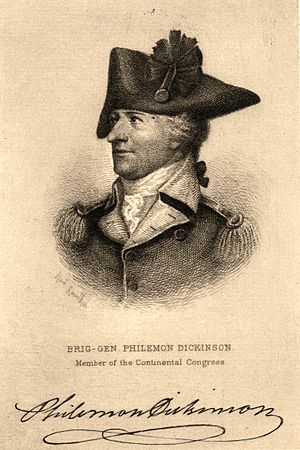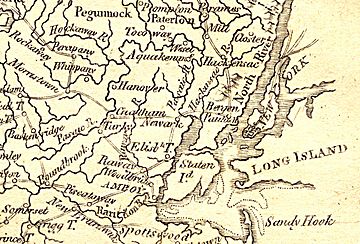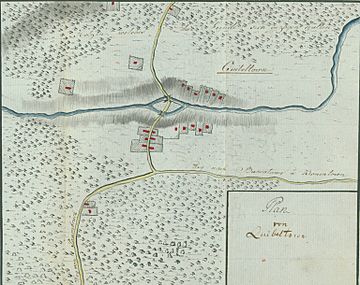Forage War facts for kids
Quick facts for kids Forage War |
|||||||
|---|---|---|---|---|---|---|---|
| Part of the American Revolutionary War | |||||||
 New Jersey militia commander Philemon Dickinson |
|||||||
|
|||||||
| Belligerents | |||||||
|
|
|||||||
| Commanders and leaders | |||||||
| George Washington William Maxwell Philemon Dickinson and others... |
Charles Mawhood Johann Ewald and others... |
||||||
| Strength | |||||||
| Thousands of militia, several companies of regulars | 10,000 (New Jersey garrison size) | ||||||
| Casualties and losses | |||||||
| Unknown | at least 954 killed, wounded or captured | ||||||
The Forage War was a series of small battles and attacks in New Jersey during the American Revolutionary War. It happened between January and March 1777, right after the important battles of Trenton and Princeton. After both the British and American armies settled into their winter camps, American soldiers and local fighters (called militia) from New Jersey and Pennsylvania started many small missions. They would scout out the enemy and bother the British and German troops who were staying in New Jersey.
The British soldiers needed fresh food for themselves and fresh hay (called forage) for their horses and other animals. General George Washington ordered his troops to remove these supplies from areas the British could easily reach. American militia and soldiers then attacked British and German groups trying to get these supplies. Many of these fights were small, but some grew quite large, involving over 1,000 soldiers. The American efforts were so successful that the British lost more soldiers in New Jersey (including the battles of Trenton and Princeton) than they did in the entire New York campaign.
Contents
Why the War Started
In August 1776, the British army began a plan to take control of New York City. This city was defended by George Washington's Continental Army. Over the next two months, General William Howe quickly took New York. He then pushed Washington's army into New Jersey. Washington had to retreat across the Delaware River into Pennsylvania. He made sure to take all the boats with him so the British couldn't follow.
Howe then told his army to settle into winter camps. They set up a line of outposts across New Jersey. These stretched from the Hudson River through New Brunswick to Trenton and Bordentown. British and German soldiers staying in New Jersey caused problems with the local people. This made more local people join the Patriot militia. By mid-December, these militia groups were already bothering British patrols. This led to incidents like Geary's ambush, where a British cavalry leader was killed. This made things even more tense for the British and Germans.
On the night of December 25–26, 1776, Washington famously crossed the Delaware River. The next morning, December 26, he surprised the British outpost at Trenton. Over the next two weeks, he won two more battles. These were at Assunpink Creek and Battle of Princeton. These victories made the British retreat to northern New Jersey. This short period, from December 25, 1776, to January 3, 1777, is known as the Ten Crucial Days.
Where the Armies Were Located
General Washington set up his main camp in Morristown. This town was protected from the coast by the Watchung Mountains. These are a series of low hills. He also set up smaller camps to the east and south of these hills. These camps helped defend against British attacks. They also served as starting points for American raids.
During January and February, Washington's main army (the Continental Army) became smaller. Many soldiers' enlistment times ended. It shrank to about 2,500 regular soldiers. However, many militia members from New Jersey, New York, and Pennsylvania joined them. These local fighters played a very important role that winter.
The British army was first spread out from Hackensack down to New Brunswick. Their main force, about 10,000 soldiers, was gathered between New Brunswick and Amboy. A large group was also further north, from Elizabethtown to Paulus Hook. In January, attacks from the militia made General Cornwallis pull most of his northern troops back to the Hudson River shores.
This meant too many soldiers were crowded together. There wasn't enough housing, as residents had left. Some soldiers even lived on ships nearby. The crowded conditions led to more sickness in the camps. Morale was low. The area had been heavily looted during the American retreat in the fall. So, there was little local food. Soldiers mostly ate things like salted pork. But their horses and other animals needed fresh food. So, the British sent out groups to find supplies.
Battle Strategies and Tactics
Early in the winter, Washington sent groups of soldiers to remove all remaining food and animals. They wanted to keep them away from the British. General Cornwallis sent out small groups to find food and raid in January. But these groups were met by larger American militia forces, sometimes with help from the Continental Army. These encounters sometimes led to many British losses.
For example, on January 20, Brigadier General Philemon Dickinson gathered 450 militia. They successfully chased away a British group looking for food in the Battle of Millstone. Washington gave his commanders a lot of freedom. He told them to "constantly harass the enemy" and to be aggressive. These early successes were partly due to good information. One British commander reported being attacked by a strong force. This happened "notwithstanding the Orders were given, but a few hours before the Troops moved."
Even supply wagons bringing food from outside New Jersey to the large British camp at New Brunswick were attacked. The Raritan River and roads from Perth Amboy offered good spots for sniping and raids. Because of these problems, British commanders changed their plans. They tried to trick American militia units into traps using more British regular soldiers.
But even this didn't work perfectly. Clever militia and Continental commanders, like General William Maxwell, used their better knowledge of the land. They set even more complex traps. In one fight in late February, British Colonel Charles Mawhood thought he had surrounded a group of New Jersey militia. But then his own leading force was suddenly surrounded by another, larger American force. As they were pushed back toward Amboy, more and more Americans appeared. In the end, the British lost about 100 soldiers. The best soldiers of the 42nd Foot, who were part of Mawhood's leading group, were badly beaten. A British force of 2,000 soldiers was pushed back by Maxwell in another well-planned attack a few weeks later.
The constant fighting wore down the British. Johann Ewald, a German captain whose light infantry soldiers were often on the front lines, wrote about it. He said, "the men have to stay dressed day and night... the horses constantly saddled." He also noted that "the army would have been gradually destroyed through this foraging." Some food was brought from New York, but it was never enough. So, the British had to bring many supplies from Europe. This was very expensive and risky for the Royal Navy.
Key Battles and Skirmishes
Many small battles and skirmishes happened during the Forage War. Here are a few examples:
Elizabethtown Skirmishes
In early January 1777, American militia attacked British soldiers near Elizabethtown. On January 5, a British cavalry patrol was ambushed. One soldier was killed. The next day, about 50 German soldiers and some cavalry were attacked by New Jersey militia near Springfield. The German soldiers were captured. On January 7, as the British left Elizabethtown, the militia attacked their rear. The Americans captured 100 soldiers, their supplies, and food.
Chatham, Connecticut Farms, and Bonhamtown
On January 10, 1777, American Colonel Charles Scott's soldiers captured 70 British Highlanders and their wagons near Chatham, New Jersey. A few days later, on January 15, 300 New Jersey militia attacked 100 German soldiers looking for food at Connecticut Farms. The Americans killed one enemy soldier and captured 70. The next day, 350 Americans attacked a large group of British foragers at Bonhamtown, New Jersey. They killed 21 enemy soldiers and wounded many more.
Millstone and Woodbridge
At the Battle of Millstone, Brigadier General Philemon Dickinson of the New Jersey militia had a great victory. On January 20, 1777, near Van Nest's Mill, 400 militia and 50 Pennsylvania riflemen crossed an icy stream. They fought 500 British soldiers and three cannons. The British lost 25 soldiers, 12 prisoners, and many wagons, horses, and cattle. The Americans only lost four or five men. After this, the British found it hard to believe they had been beaten by militia.
On January 23, two British regiments were ambushed by Brigadier General William Maxwell near Woodbridge. Maxwell's 200 New Jersey soldiers killed seven British and wounded 12. The Americans only had two men wounded.
Drake's Farm
On February 1, 1777, British Brigadier General Sir William Erskine, 1st Baronet set a trap. He sent a small group of foragers to Drake's Farm near Metuchen. When American Colonel Scott's soldiers tried to attack this small group, Erskine brought in his larger force. British and German soldiers with eight cannons appeared. Instead of running, the Americans attacked fiercely. They even broke through a British grenadier group for a moment. The Americans fought hard even under heavy cannon fire. They only stopped when the British retreated toward Brunswick. The Americans lost 30 to 40 soldiers. They claimed to have killed 36 British and wounded 100.
This battle had a sad event. Lieutenant William Kelly and six other wounded Americans were left behind when their side pulled back. The angry British soldiers attacked these seven helpless men with bayonets and musket butts, killing them all. When the Americans found the bodies, they were furious. General Adam Stephen sent angry letters to Erskine, who said he was not responsible.
Quibbletown
On February 8, 1777, General Cornwallis led a large British force of about 2,000 soldiers. They planned to attack American militia and soldiers near Quibbletown, New Jersey. However, the Americans avoided a direct fight. Instead, they attacked the British from the sides and rear as they retreated to New Brunswick. Historian David Fischer wrote that "The British commanders were outgeneraled in the field." German Captain Johann von Ewald wrote in his diary that because the army was being "gradually destroyed through this foraging," from then on, food was brought from New York.
Counting the Losses
Historian David Hackett Fischer made a list of 58 battles and actions that happened between January 4 and March 21, 1777. The British and German armies lost more than 900 soldiers in these events. Some of the events don't even have casualty numbers. When you add these to their losses at Trenton and Princeton, the British lost more men in New Jersey than they did during the entire campaign for New York City.
How the War Ended
The main military plans for 1777 started to take shape in April. General Charles Cornwallis ended the winter skirmishes with an attack on the American outpost at Bound Brook on April 13. In the Battle of Bound Brook, he almost captured its commander, Benjamin Lincoln. The British had 2,000 soldiers against 500 Americans. They scattered the militia but faced strong resistance from the 8th Pennsylvania Regiment. The British captured three cannons and 20 or 30 men, and killed six Americans. But most of Lincoln's force escaped.
General Washington moved his army from its winter camp at Morristown to a better position at Middlebrook in late May. This allowed him to react more easily to British moves. As General Howe prepared his Philadelphia campaign, he first moved a large part of his army to Somerset Court House in mid-June. He seemed to be trying to make Washington leave his Middlebrook position. When this didn't work, Howe pulled his army back to Perth Amboy. He then loaded them onto ships headed for the Chesapeake Bay. Northern and coastal New Jersey continued to have small fights and raids by the British forces who occupied New York City for the rest of the war.
|




